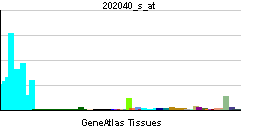JARID1A
| Jumonji, AT rich interactive domain 1A | |||||||||||
|---|---|---|---|---|---|---|---|---|---|---|---|
| Identifiers | |||||||||||
| Symbols | JARID1A ; RBBP2; RBP2 | ||||||||||
| External IDs | Template:OMIM5 Template:MGI HomoloGene: 3419 | ||||||||||
| |||||||||||
| RNA expression pattern | |||||||||||
 | |||||||||||
 | |||||||||||
| More reference expression data | |||||||||||
| Orthologs | |||||||||||
| Template:GNF Ortholog box | |||||||||||
| Species | Human | Mouse | |||||||||
| Entrez | n/a | n/a | |||||||||
| Ensembl | n/a | n/a | |||||||||
| UniProt | n/a | n/a | |||||||||
| RefSeq (mRNA) | n/a | n/a | |||||||||
| RefSeq (protein) | n/a | n/a | |||||||||
| Location (UCSC) | n/a | n/a | |||||||||
| PubMed search | n/a | n/a | |||||||||
Jumonji, AT rich interactive domain 1A, also known as JARID1A, is a human gene.[1]
The protein encoded by this gene is a ubiquitously expressed nuclear protein. It binds directly, with several other proteins, to retinoblastoma protein which regulates cell proliferation. It was formally known as Retinoblastoma Binding Protein 2 (RBP2). This protein also interacts with rhombotin-2 which functions distinctly in erythropoiesis and in T-cell leukemogenesis. Rhombotin-2 is thought to either directly affect the activity of the encoded protein or may indirectly modulate the functions of the retinoblastoma protein by binding to this protein. Alternatively spliced transcript variants encoding distinct isoforms have been found for this gene.[1]
This protein was found to be an H3K4 histone demethylase that binds to c-Myc. [2] It was recently renamed to Lysine Demethylase 5A (KDM5A).
References
- ↑ 1.0 1.1 "Entrez Gene: JARID1A jumonji, AT rich interactive domain 1A".
- ↑ Secombe J, Li L, Carlos L, Eisenman RN (2007). "The Trithorax group protein Lid is a trimethyl histone H3K4 demethylase required for dMyc-induced cell growth". Genes Dev. 21 (5): 537–51. doi:10.1101/gad.1523007. PMID 17311883.
Further reading
- Defeo-Jones D, Huang PS, Jones RE; et al. (1991). "Cloning of cDNAs for cellular proteins that bind to the retinoblastoma gene product". Nature. 352 (6332): 251–4. doi:10.1038/352251a0. PMID 1857421.
- Kim YW, Otterson GA, Kratzke RA; et al. (1994). "Differential specificity for binding of retinoblastoma binding protein 2 to RB, p107, and TATA-binding protein". Mol. Cell. Biol. 14 (11): 7256–64. PMID 7935440.
- Maruyama K, Sugano S (1994). "Oligo-capping: a simple method to replace the cap structure of eukaryotic mRNAs with oligoribonucleotides". Gene. 138 (1–2): 171–4. PMID 8125298.
- Fattaey AR, Helin K, Dembski MS; et al. (1993). "Characterization of the retinoblastoma binding proteins RBP1 and RBP2". Oncogene. 8 (11): 3149–56. PMID 8414517.
- Baens M, Aerssens J, van Zand K; et al. (1996). "Isolation and regional assignment of human chromosome 12p cDNAs". Genomics. 29 (1): 44–52. doi:10.1006/geno.1995.1213. PMID 8530100.
- Andersson B, Wentland MA, Ricafrente JY; et al. (1996). "A "double adaptor" method for improved shotgun library construction". Anal. Biochem. 236 (1): 107–13. doi:10.1006/abio.1996.0138. PMID 8619474.
- Hillier LD, Lennon G, Becker M; et al. (1997). "Generation and analysis of 280,000 human expressed sequence tags". Genome Res. 6 (9): 807–28. PMID 8889549.
- Yu W, Andersson B, Worley KC; et al. (1997). "Large-scale concatenation cDNA sequencing". Genome Res. 7 (4): 353–8. PMID 9110174.
- Mao S, Neale GA, Goorha RM (1997). "T-cell oncogene rhombotin-2 interacts with retinoblastoma-binding protein 2". Oncogene. 14 (13): 1531–9. doi:10.1038/sj.onc.1200988. PMID 9129143.
- Suzuki Y, Yoshitomo-Nakagawa K, Maruyama K; et al. (1997). "Construction and characterization of a full length-enriched and a 5'-end-enriched cDNA library". Gene. 200 (1–2): 149–56. PMID 9373149.
- Chan SW, Hong W (2001). "Retinoblastoma-binding protein 2 (Rbp2) potentiates nuclear hormone receptor-mediated transcription". J. Biol. Chem. 276 (30): 28402–12. doi:10.1074/jbc.M100313200. PMID 11358960.
- Sandrock B, Egly JM (2001). "A yeast four-hybrid system identifies Cdk-activating kinase as a regulator of the XPD helicase, a subunit of transcription factor IIH". J. Biol. Chem. 276 (38): 35328–33. doi:10.1074/jbc.M105570200. PMID 11445587.
- Strausberg RL, Feingold EA, Grouse LH; et al. (2003). "Generation and initial analysis of more than 15,000 full-length human and mouse cDNA sequences". Proc. Natl. Acad. Sci. U.S.A. 99 (26): 16899–903. doi:10.1073/pnas.242603899. PMID 12477932.
- Ota T, Suzuki Y, Nishikawa T; et al. (2004). "Complete sequencing and characterization of 21,243 full-length human cDNAs". Nat. Genet. 36 (1): 40–5. doi:10.1038/ng1285. PMID 14702039.
- Beausoleil SA, Jedrychowski M, Schwartz D; et al. (2004). "Large-scale characterization of HeLa cell nuclear phosphoproteins". Proc. Natl. Acad. Sci. U.S.A. 101 (33): 12130–5. doi:10.1073/pnas.0404720101. PMID 15302935.
- Benevolenskaya EV, Murray HL, Branton P; et al. (2005). "Binding of pRB to the PHD protein RBP2 promotes cellular differentiation". Mol. Cell. 18 (6): 623–35. doi:10.1016/j.molcel.2005.05.012. PMID 15949438.
- Kimura K, Wakamatsu A, Suzuki Y; et al. (2006). "Diversification of transcriptional modulation: large-scale identification and characterization of putative alternative promoters of human genes". Genome Res. 16 (1): 55–65. doi:10.1101/gr.4039406. PMID 16344560.
- Tzschach A, Lenzner S, Moser B; et al. (2006). "Novel JARID1C/SMCX mutations in patients with X-linked mental retardation". Hum. Mutat. 27 (4): 389. doi:10.1002/humu.9420. PMID 16541399.
- Roesch A, Becker B, Schneider-Brachert W; et al. (2006). "Re-expression of the retinoblastoma-binding protein 2-homolog 1 reveals tumor-suppressive functions in highly metastatic melanoma cells". J. Invest. Dermatol. 126 (8): 1850–9. doi:10.1038/sj.jid.5700324. PMID 16645588.
- Olsen JV, Blagoev B, Gnad F; et al. (2006). "Global, in vivo, and site-specific phosphorylation dynamics in signaling networks". Cell. 127 (3): 635–48. doi:10.1016/j.cell.2006.09.026. PMID 17081983.
External links
- JARID1A+protein,+human at the US National Library of Medicine Medical Subject Headings (MeSH)
| This protein-related article is a stub. You can help Wikipedia by expanding it. |
This article incorporates text from the United States National Library of Medicine, which is in the public domain.